Zoonotic Risk: One More Good Reason Why Cats Should Be Kept Away from Bats
- PMID: 33807760
- PMCID: PMC8002059
- DOI: 10.3390/pathogens10030304
Zoonotic Risk: One More Good Reason Why Cats Should Be Kept Away from Bats
Abstract
Bats are often unfairly depicted as the direct culprit in the current COVID-19 pandemic, yet the real causes of this and other zoonotic spillover events should be sought in the human impact on the environment, including the spread of domestic animals. Here, we discuss bat predation by cats as a phenomenon bringing about zoonotic risks and illustrate cases of observed, suspected or hypothesized pathogen transmission from bats to cats, certainly or likely following predation episodes. In addition to well-known cases of bat rabies, we review other diseases that affect humans and might eventually reach them through cats that prey on bats. We also examine the potential transmission of SARS-CoV-2, the causal agent of COVID-19, from domestic cats to bats, which, although unlikely, might generate a novel wildlife reservoir in these mammals, and identify research and management directions to achieve more effective risk assessment, mitigation or prevention. Overall, not only does bat killing by cats represent a potentially serious threat to biodiversity conservation, but it also bears zoonotic implications that can no longer be neglected.
Keywords: COVID-19; SARS-CoV-2; bat; cat; spillback; spillover; zoonotic risk.
Conflict of interest statement
The authors declare no conflict of interests.
Figures


Similar articles
-
Assessing the extent and public health impact of bat predation by domestic animals using data from a rabies passive surveillance program.PLOS Glob Public Health. 2022 May 11;2(5):e0000357. doi: 10.1371/journal.pgph.0000357. eCollection 2022. PLOS Glob Public Health. 2022. PMID: 36962180 Free PMC article.
-
A First Assessment of SARS-CoV-2 Circulation in Bats of Central-Southern Italy.Pathogens. 2022 Jun 29;11(7):742. doi: 10.3390/pathogens11070742. Pathogens. 2022. PMID: 35889988 Free PMC article.
-
Animals and SARS-CoV-2: Species susceptibility and viral transmission in experimental and natural conditions, and the potential implications for community transmission.Transbound Emerg Dis. 2021 Jul;68(4):1850-1867. doi: 10.1111/tbed.13885. Epub 2020 Nov 4. Transbound Emerg Dis. 2021. PMID: 33091230 Free PMC article. Review.
-
Bat rabies surveillance and risk factors for rabies spillover in an urban area of Southern Brazil.BMC Vet Res. 2018 Jun 1;14(1):173. doi: 10.1186/s12917-018-1485-1. BMC Vet Res. 2018. PMID: 29859078 Free PMC article.
-
Have artificial lighting and noise pollution caused zoonosis and the COVID-19 pandemic? A review.Environ Chem Lett. 2021;19(6):4021-4030. doi: 10.1007/s10311-021-01291-y. Epub 2021 Jul 31. Environ Chem Lett. 2021. PMID: 34366755 Free PMC article. Review.
Cited by
-
Habitat sharing and interspecies interactions in caves used by bats in the Republic of Congo.PeerJ. 2025 Jan 9;13:e18145. doi: 10.7717/peerj.18145. eCollection 2025. PeerJ. 2025. PMID: 39802183 Free PMC article.
-
Microbial community dynamics in blood, faeces and oral secretions of neotropical bats in Casanare, Colombia.Sci Rep. 2024 Oct 28;14(1):25808. doi: 10.1038/s41598-024-77090-6. Sci Rep. 2024. PMID: 39468253 Free PMC article.
-
Molecular Survey of Toxoplasma gondii in Wild Mammals of Southern Italy.Pathogens. 2023 Mar 16;12(3):471. doi: 10.3390/pathogens12030471. Pathogens. 2023. PMID: 36986393 Free PMC article.
-
Variations in Cell Surface ACE2 Levels Alter Direct Binding of SARS-CoV-2 Spike Protein and Viral Infectivity: Implications for Measuring Spike Protein Interactions with Animal ACE2 Orthologs.J Virol. 2022 Sep 14;96(17):e0025622. doi: 10.1128/jvi.00256-22. Epub 2022 Aug 24. J Virol. 2022. PMID: 36000847 Free PMC article.
-
SARS-CoV-2 infection in domestic and feral cats: current evidence and implications.Vet Q. 2021 Dec;41(1):228-231. doi: 10.1080/01652176.2021.1962576. Vet Q. 2021. PMID: 34319851 Free PMC article.
References
Grants and funding
LinkOut - more resources
Full Text Sources
Other Literature Sources
Miscellaneous

